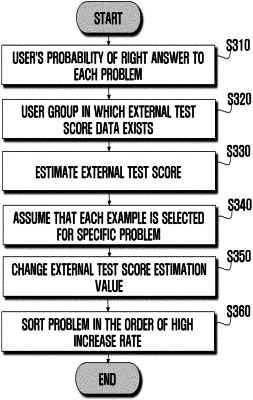| CPC G06N 5/04 (2013.01) [G06N 20/00 (2019.01); G09B 7/06 (2013.01)] | 6 Claims |

|
1. A method of analyzing a user in a server, comprising:
a) for a specific subject, configuring, using the server, a problem database comprising one or more multiple-choice problems, providing, using the server, at least one problem of the one or more multiple choice problems to user devices, collecting, using the server, one or more selected answers of users for the at least one problem from the user devices, and storing, using the server, the one or more selected answers of the users for the at least one problem in the problem database, wherein the users and the one more multiple choice problems are stored as modeling vectors in a machine learning framework;
b) estimating, using the server and modeling vectors in the machine learning framework, a probability of a right answer to the at least one problem for each of the users using values stored in a multidimensional plane;
c) for the specific subject, analyzing, using the server, external test score data of a first user group, wherein the external test score data is associated with an external test that is external to the one or more multiple-choice questions contained within the problem database, and generating, using the server, a mock test problem set from the one or more multiple-choice problems in the problem database to predict an external test score of at least one second group user of a second user group which has not taken the external test, wherein the mock test problem set is generated by collecting one or more mock test problems from the one or more multiple-choice problems that are predicted to result in similar mock test score data as the external test score data of the first user group; and
d) estimating, using the server, a predicted mock test score of the mock test problem set for the at least one second group user of the second user group without providing the mock test problem set to the at least one second group user of the second user group, and estimating, using the server, the predicted mock test score of the mock test problem set as a predicted external test score for the external test.
|